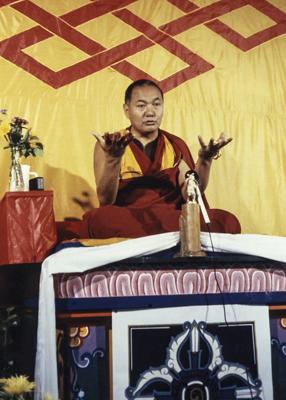The main body of any yoga method begins with meditation on emptiness, or, in Sanskrit, shunyata. This is sometimes called the shunyata deity, but that’s just a philosophical term. Anyway, we’re all meditating on emptiness already. We started a long time ago. Ages ago.
We begin our meditation on emptiness by contemplating on the clean clear nature of our own thought, or mind. This approach is important.
First, it’s crucial that we employ introspective wisdom to investigate what the mind is. Mind is the nuclear energy that produces all the different kinds of life. Basic Buddhist philosophy teaches that in the evolution of sentient beings’ existence, the root of life is the mind. Mind is the creator of body and life.
THE MEDITATION OBJECT
When we talk about meditation, what is it that we meditate on? There has to be an object involved; there is an object of meditation. We have to be clean clear about that also. We have to start our meditation by recognizing one particular object, otherwise our meditation will get lost. We have to start somewhere and anybody who instructs others in meditation has to point out to them exactly what the meditation object is.
If we try to meditate without having a clear idea of the object we’ll just space out and get nowhere. That’s not what Buddhism understands meditation to be. We’ve been spaced out long enough. So this time, instead of letting our mind wander about lost in a cloud of distracted thought and reacting to whatever arises, we need to bring it to a stop and focus on an object.
This is how we should meditate on the lamrim as well. Lamrim meditation is not a joke. It’s a serious undertaking where we pick one aspect of reality and investigate it thoroughly through analytical meditation. We really focus our mind on the particular topic we have chosen and don’t allow it to wander this way or that. Doing that properly also takes much time.
So anyway, whether we’re doing analytical meditation or practicing single-pointed concentration, we need to focus our mind on one object. This is how we start to control our mad elephant mind, and that’s the purpose of meditation—to direct the mad elephant mind in the right direction. So when we meditate we should not lose the point of why we’re doing it.
Of course, when we start trying to focus our mind, distracting thoughts will come. Instead of getting upset by and rejecting them, we must learn to watch them skillfully. That doesn’t mean we’ve lost our object, lost the point. What happens when we handle distractions skillfully is that our mind comes back to the point instead of cycling around from one scattered thought to another.
WHERE IS YOUR I?
So now, this is very important: when we start by focusing on the essence of thought, or consciousness, which is formless and colorless, like space, we give ourselves access to recognizing the way our ego interprets our self, or I. When we investigate that further, we come to the conclusion that there’s no such self. It’s a big zero, and that is the universal truth of emptiness, or nonduality. Our ego’s interpretation, our concrete conception, of the I, which appears to be indestructible in nature, is false. It’s a wrong view.
So when you think, “I want to be happy; I don’t want to suffer,” ask yourself the question, “Where is that I?” Wherever you are, whatever you’re doing, ask yourself that question.
Many years ago in Tibet, His Holiness Trijang Rinpoche told us the story of a lama who instructed his disciple, “Today I want you to search for your I. Go up into the mountains and see if it’s there.” The monk took him very seriously and went about everywhere, looking for his I. Eventually he came back and told his guru very earnestly, “I looked everywhere but I couldn’t find it.”
So, in fact, he was successful, wasn’t he?
Our biggest problem, our main symptom, is that for us, the huge, universal reality is our self-imagined I, which renders “other” as nothing. Our extremely sophisticated ego makes everything so complicated. Reality is simple but our ego totally embellishes it with a hundred different flavors, like ice cream. Actually, all those different flavors of ice cream are also simply projections of our ego.
Because our ego makes everything so complicated, our mind is constantly quivering with superstition and never able to remain calm and clear. But when we meditate on our breath, for example, we can still our mind and reach a point of clarity. Then we simply focus on that; we rest our mind in clarity instead of constant reaction, reaction, reaction, and let go. When we contemplate the clarity of our own consciousness, our trembling ego superstitions are gradually eliminated and a non-ego, non-I experience arises in our mind.
This experience allows our pure, inner nature to function and that allows our psychic, or conscious, body to manifest strongly so that we can arise as the deity we’re practicing. If we don’t eliminate our gross levels of ego and still cling to the illusory I, it will be very difficult for us to become the deity.































